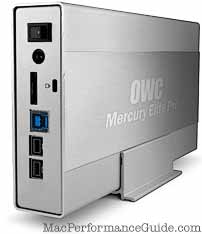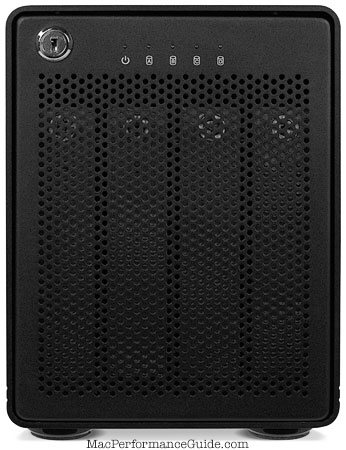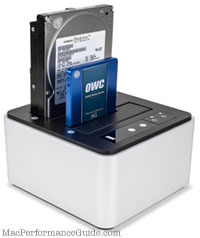Reader Question: Backup Drive for a RAID
Ivan writes:
I’m thinking of updating my old Qx2 Raid 5 backup drive. Its a back up of my other Raid 5 external (Promise Pegasus 8TB).
The Qx2 has been acting up lately and I’ve had to reformat it several times to get it to work, and concerned about it. Its 4 years old.
I just wanted to run it by you, either get another backup, like the Thunderbay4 Raid 5 (8TB), or do the cloud thing. I’m using a MP (garbage can).
What is your opinion? BTW, the Pegasus has been without an issue for 2 years now.
MPG: Drives four years or older are OK as secondary or tertiary backups, but I’d dump them out of any daily scenario. Besides, 4-year-old drives are very slow compared to today’s hard drives. I recently tested a batch of 2/3/4TB drives, all 2-4 years old. Several of them had bad blocks and had to be discarded. It’s playing with fire to use drives that old unless perhaps spin time has been low.
Cloud backup is always a good adjunct, but if the data set is large then a very fast connection is needed. With a 100 X 20-megabit business-class internet connection, my own data would take 6 weeks to upload and saturate the link—not an attractive idea. Even a single photo trip backup might be up to 300GB, and a backup that takes many days is not a backup until it has finished—too long. For cloud backup, there may also be usability issues in keeping daily changes up to date, multiple volumes, etc; it all depends on specifics. But of course more backups and backups of different kinds in different places is a great idea.
In general, RAID for true backups is not the smart move. The purpose of backup is to forestall data loss, but a RAID takes more drives for the same number of backups, and also adds hardware and/or software complexity: these are additional risks. And unless a RAID is also fault tolerant, then it is at higher risk than a single drive (for example, using a RAID-0 stripe as a backup). The appeal of a RAID is additional fault tolerance (RAID-1 mirror or RAID-4/5) and/or higher performance, but for the same money fewer backups can be had, and that is self defeating unless money is no object.
RAID is NOT a substitute for multiple backups! See Risks To Data Go Far Beyond Drive Failure and Dangerous (to your data) Misconceptions about Backup.
Best practices
First of all, fault tolerance is independent of backup. Fault-tolerance is for avoiding downtime. Too often it is confused with backup. Fault tolerance (e.g., some types of RAID) is NOT a backup.
The best approach for backup is more and thus redundant backups. MPG recommends at least two and preferably three full backups, stored away from the computer (preferably at another site). Backups should offer redundancy, separability and independence and minimized dependencies.
- Redundancy: more than one backup, at least two and preferably three or more. The more valuable the data, the more backups and the more frequently to backup.
- Separability: each backup should be physically separable from the others so that it can be stored in a physically different location (away from the computer). Examples: home and office and safe deposit box and trunk of car.
- Independence: more than one backup on a single device is self defeating. It makes no sense to have two backup volumes (of the same source) on the same drive(s). [For example, Adobe Lightroom is willing to backup its catalog to the same drive as the original, a pointless approach].
- Minimized dependencies: MPG is not a fan of backups that require special software, store in a special format, etc. Software has bugs, software may become incompatible, etc.
Type of backups
Risks to data include hardware failure, software or user errors and physical threats. All three are best handled by a combination of always attached backups and offsite backups:
- An always-attached backup volume, so that a clone backup can be made each day, or even several times a day, such as after downloading a photography shoot, finishing an editing job, etc.
- An always-attached Time Machine (or Time apsule) backup volume which complements the clone backup. Also handy: the command right in the menu bar.
- At least two and preferably three or more backups stored safely away from the comuter, preferable at another location (Cloud backup falls into this category).
The first two points above are at-risk backups in terms of physical threats like theft, fire, flood, lightning strike, etc. That is why the offsite backups are critical. And yet using only offsite backups is a very bad idea in practice, because in practice backups might not happen for days or weeks at a time. That is the purpose of daily backups as per above: mitigating hardware failure and/or errors.
Recommended drives for backup
Single-drive backups afford the greatest number of independent backups at the lowest cost—the best redundancy. Single drives can be self-contained standalone external drives like the OWC Mercury Elite Pro. Or they can be bare drives inserted into a device like the OWC Drive Dock or semi-bare drives in drive sleds that slot into a device like the OWC Thunderbay 4 (removed after backup is made and/or used for the always-attached backups as discussed above).
While single drives are not as fast as a RAID-0 or RAID-5, the use of cloning makes updating backups very fast, and several independent backup drives is hugely preferable to one RAID, for the reasons discussed above.
Need help figuring out the best backup approach? MPG offers consulting.

 diglloydTools™
diglloydTools™









